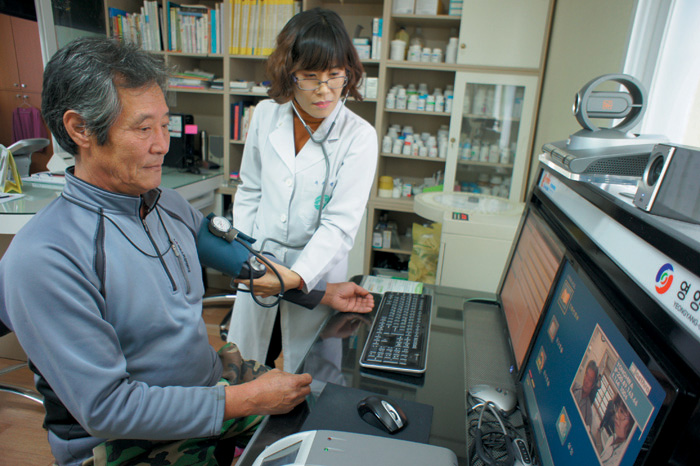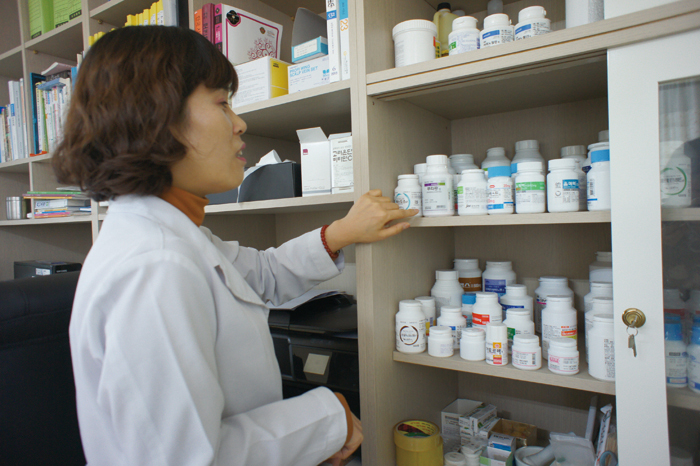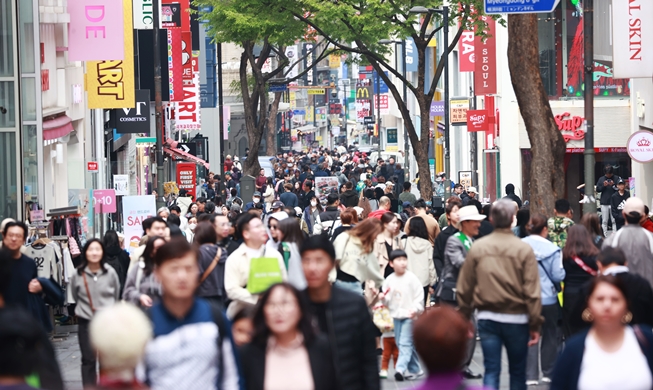-
 Korea.net's 24-hour YouTube channel
Korea.net's 24-hour YouTube channel- NEWS FOCUS
- ABOUT KOREA
- EVENTS
- RESOURCES
- GOVERNMENT
- ABOUT US
In December 2013, Kim Gil-su, a 63-year-old resident of Yeongyang County, Gyeongsangbuk-do (North Gyeongsang Province), travelled 20 kilometers to get to a public health center. With the government’s new telemedicine system of offering health care remotely to distant communities, he can now receive the medical attention he needs at the center.
“I initially started receiving telemedicine services because of high blood pressure,” Kim said. “I was diagnosed with high blood pressure in 2011 but because of the farm work I do, it is difficult to get to a hospital on a regular basis.”
“There is a hospital in Yeongyang County, but the type of medical service it provides is very limited,” he lamented. “To go to another hospital in Andong or Daegu is difficult because they are very far from my home; it could take at least two hours or even an entire day to just see a doctor for a few minutes.”

Telemedicine service started in Yeongyang County after the town was selected in 2008 as one of the few places across the country with an insufficient number of medical establishments. The other two communities were Gangneung in Gangwon-do (Gangwon Province) and Boryeong in Chungcheongnam-do (South Chungcheong Province). The government decided to offer pilot telemedicine services in these three towns and in 2009 established a telemedicine imaging system that connects 14 public health clinics and three hospitals.
Telemedicine services were adopted in order to complement face-to-face medical treatment. It’s mainly provided to patients with chronic illnesses who need long-term treatment, seniors and the disabled who have difficulties in moving and people living on remote islands or in the smaller towns, far from hospitals.
Yeongyang Country, where Kim lives, is over 814 square kilometers, some 1.3 times larger than Seoul proper. But the remote Gyeongsangbuk-do area is scarcely populated, having only 18,000 people. Those who are 65-years-old or older account for over 30 percent of its population, the second highest elderly-rate in the country. There are only five hospitals and they are all located in the county center. There isn’t much in the way of public transportation and it is difficult to commute to the town center, not to mention the fact that it is hard for some elderly to drive to the hospital.
“Unless their children take them to the hospital, it is hard for them to see a doctor,” said a manager at a county public health clinic. “Many of them are too sick to walk alone. They also have a hard time explaining their symptoms. Also, unless it is an acute illness or serious disease, it is better for them to receive telemedicine services at a public health center nearby where the medical professionals are acquainted with the residents and the neighborhood.”
“Telemedicine services initially started as a one-year pilot project, but the residents have given favorable responses and the service continued. In 2011, it became a permanent project,” another health center official said. “For first-time consultations, however, patients still must see a doctor in person.”

The number of telemedicine cases has risen 2.7 times from 1,770 in 2009 to 4,853 in 2012. In a May 2013 survey of 182 residents of Yeongyang County who received telemedicine services, 81.3 percent replied that they are satisfied with the service.
Now, telemedicine services are spreading beyond the initial three towns to nearby regions. Across all of Gangwon-do now, including Gangneung, patients with high blood pressure or diabetes can now receive telemedicine services after their first person-to-person consultation. Those who are diagnosed with Alzheimer’s disease are also benefiting from telemedicine.
In 2009, Seosan in Chungcheongnam-do was added to the list of telemedicine towns. Now, both Boryeong and Seosan have established telemedicine networks, linking up public health centers, hospitals and pharmacies, in order to provide better health care services to patients living on isolated islands and in remote areas.
By Limb Jae-un
Korea.net Staff Writer
jun2@korea.kr

“I initially started receiving telemedicine services because of high blood pressure,” Kim said. “I was diagnosed with high blood pressure in 2011 but because of the farm work I do, it is difficult to get to a hospital on a regular basis.”
“There is a hospital in Yeongyang County, but the type of medical service it provides is very limited,” he lamented. “To go to another hospital in Andong or Daegu is difficult because they are very far from my home; it could take at least two hours or even an entire day to just see a doctor for a few minutes.”

In Yeongyang County, Gyeongsangbuk-do, an aging town with a declining population and inconvenient public transportation, telemedicine services started in 2009. So far, it has been well received by the residents. (Photo courtesy of Weekly Gonggam)
Telemedicine service started in Yeongyang County after the town was selected in 2008 as one of the few places across the country with an insufficient number of medical establishments. The other two communities were Gangneung in Gangwon-do (Gangwon Province) and Boryeong in Chungcheongnam-do (South Chungcheong Province). The government decided to offer pilot telemedicine services in these three towns and in 2009 established a telemedicine imaging system that connects 14 public health clinics and three hospitals.
Telemedicine services were adopted in order to complement face-to-face medical treatment. It’s mainly provided to patients with chronic illnesses who need long-term treatment, seniors and the disabled who have difficulties in moving and people living on remote islands or in the smaller towns, far from hospitals.
Yeongyang Country, where Kim lives, is over 814 square kilometers, some 1.3 times larger than Seoul proper. But the remote Gyeongsangbuk-do area is scarcely populated, having only 18,000 people. Those who are 65-years-old or older account for over 30 percent of its population, the second highest elderly-rate in the country. There are only five hospitals and they are all located in the county center. There isn’t much in the way of public transportation and it is difficult to commute to the town center, not to mention the fact that it is hard for some elderly to drive to the hospital.
“Unless their children take them to the hospital, it is hard for them to see a doctor,” said a manager at a county public health clinic. “Many of them are too sick to walk alone. They also have a hard time explaining their symptoms. Also, unless it is an acute illness or serious disease, it is better for them to receive telemedicine services at a public health center nearby where the medical professionals are acquainted with the residents and the neighborhood.”
“Telemedicine services initially started as a one-year pilot project, but the residents have given favorable responses and the service continued. In 2011, it became a permanent project,” another health center official said. “For first-time consultations, however, patients still must see a doctor in person.”

Patients can now receive medical treatment and prescriptions at public health clinics in some remote areas. (Photo courtesy of Weekly Gonggam)
The number of telemedicine cases has risen 2.7 times from 1,770 in 2009 to 4,853 in 2012. In a May 2013 survey of 182 residents of Yeongyang County who received telemedicine services, 81.3 percent replied that they are satisfied with the service.
Now, telemedicine services are spreading beyond the initial three towns to nearby regions. Across all of Gangwon-do now, including Gangneung, patients with high blood pressure or diabetes can now receive telemedicine services after their first person-to-person consultation. Those who are diagnosed with Alzheimer’s disease are also benefiting from telemedicine.
In 2009, Seosan in Chungcheongnam-do was added to the list of telemedicine towns. Now, both Boryeong and Seosan have established telemedicine networks, linking up public health centers, hospitals and pharmacies, in order to provide better health care services to patients living on isolated islands and in remote areas.
By Limb Jae-un
Korea.net Staff Writer
jun2@korea.kr
Most popular
- First hearing-impaired K-pop act hopes for 'barrier-free world'
- 'Mad Max' director impressed by 'cinema-literate' Korean viewers
- Romanian presidential couple visits national cemetery
- 'Korean mythology is just as wonderful as Greek and Roman'
- Hit drama 'Beef' wins awards from 3 major Hollywood guilds













